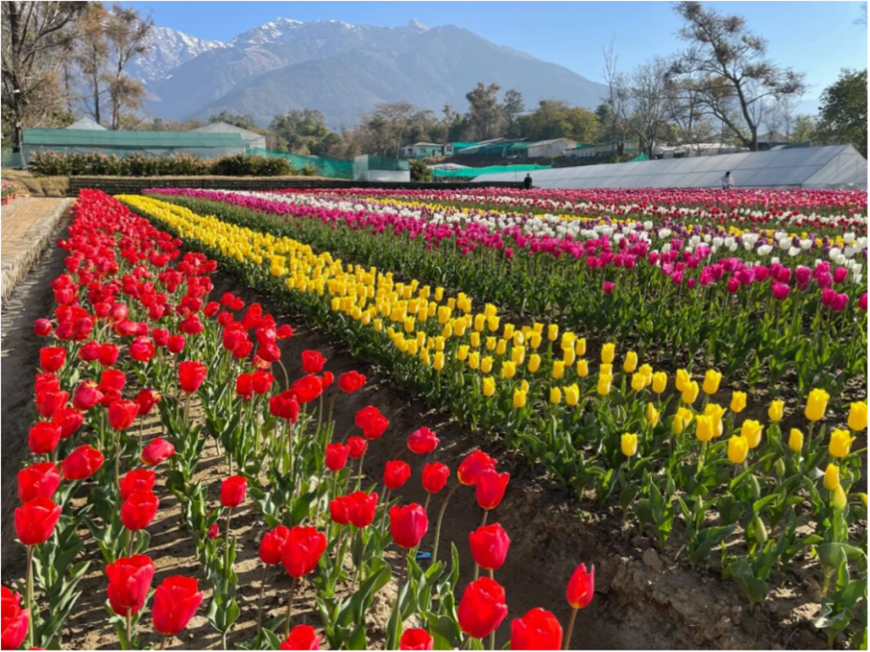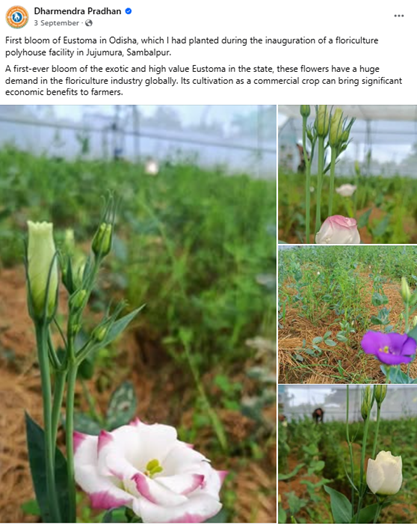भारत की विदेशी पुष्प क्रांति
Dr. Sudip Karmakar
SCDD, CSIR HQ.
India is a land of endless variety — from snow-covered mountains to golden deserts, from lush valleys to the sea-lined coasts. With such diverse landscapes and climates, our country is home to countless kinds of flowers that colour every season. Yet, some blooms have always remained out of reach — exotic flowers that flourish only in faraway lands with cooler air or gentler sunshine.
These rare flowers, much loved for their beauty and value, are often imported to meet growing demand. But that story is changing. Across India, scientists of the Council of Scientific and Industrial Research (CSIR) have been quietly working to make these delicate blossoms feel at home in Indian soil. Through years of research and patient trials, they have turned what once seemed impossible into a living, blooming reality. From the tulip fields of Himachal Pradesh to the Eustoma blooms of Odisha, their efforts are helping India grow its own share of the world’s most exquisite flowers, and giving farmers a new reason to smile.
Tulips in the Himalayas: A Garden of Dreams
Nestled in the serene hills of Palampur, Himachal Pradesh, the CSIR-Institute of Himalayan Bioresource Technology (CSIR-IHBT) has turned a scientific experiment into a breathtaking spectacle. Under the CSIR-Floriculture Mission, the institute has been cultivating tulips — one of the world’s most popular cut flowers — right on its campus.

On February 2, 2024, the institute opened its colourful Tulip Garden to the public. Inaugurated by Dr. Sudesh Kumar Yadav, Director of CSIR-IHBT, the garden dazzled visitors with 50,000 tulip bulbs of six vibrant varieties. From deep red to sunshine yellow, the garden was a painter’s palette come alive in the lap of the Dhauladhar mountains. The response was overwhelming. In 2024, more than 70,000 visitors came to witness this floral wonder; the numbers are expected to rise even higher in the coming years.
But behind the beauty lies a serious scientific mission. Tulips, native to cooler climates, are a major export commodity. Globally, they rank third in the cut-flower trade; yet, India has long relied on imported bulbs. To change that, CSIR-IHBT started experimental trials in the Lahaul valley, a region whose climate closely matches tulip-growing regions abroad.
Soon, local farmers joined in. Societies like Yaani Mahadev Floriculture Society (Madagran), Pattan Valley Floriculture Society (Shansha), and Tinan White Mountain Floriculture Society (Jangla) were trained to cultivate tulips for both bulbs and flowers. Today, these farmers are earning profits while proudly displaying their vibrant fields.
Dr. Yadav and his team envision a self-reliant future where India no longer needs to import tulip bulbs. The institute plans to produce enough tulip bulbs to meet India’s domestic demand over the next 7–8 years, moving the country toward self-reliance. With such success, the IHBT tulip garden has also become a centre for scientific tourism, blending beauty with biotechnology and making the hills bloom with opportunity.
Eustoma in Odisha: A New Bloom of Hope
Far away from the snow-kissed peaks, in the warm plains of Sambalpur, Odisha, another CSIR lab has created floral history. For the first time, the exotic North American flower Eustoma — known for its rose-like elegance and long shelf life — has bloomed in Odisha’s soil.
The achievement belongs to CSIR-National Botanical Research Institute (CSIR-NBRI), Lucknow, which supplied 2,000 seedlings to the Green Sanatanpali Farmer Producer Organisation (FPO). Among its members was 25-year-old Itish Pradhan, a young farmer who left his job at a steel plant to chase a dream in floriculture.
The FPO was provided a polyhouse along with planting materials of Eustoma through the CSIR Floriculture Mission. Shri Dharmendra Pradhan, Honourable Union Minister of Education, Government of India, inaugurated the polyhouse and planted the first Eustoma. Further on, Itish experimented the Eustoma cultivation under the guidance of scientists from CSIR-NBRI, Lucknow. Speaking to ETV Bharat, he said, “I was not very sure if such an exotic flower could survive here. But I got so much help and guidance, which included information on the importance of controlled temperature and hard work, that I succeeded.” In just four months, his hard work paid off — he harvested the first 35 beautiful Eustoma flowers in shades of pink, purple, and white.
The flowers fetched an impressive price of up to ₹1,500 per bunch in export markets. With minimal investment and scientific support, Itish’s experiment became a success story that inspired other farmers.
Eustoma’s appeal goes far beyond its beauty. It thrives in temperatures between 16°C and 28°C, ideal for controlled cultivation. According to CSIR-NBRI, it can be harvested twice a year, yielding profits of up to ₹2 lakh per acre. Dr. Ajit Kumar Shasany, Director of CSIR-NBRI, told The Hindu, “This initiative not only creates new opportunities for farmers but also introduces high-value exotic flowers to Indian markets.”
When the first blooms appeared, Shri Dharmendra Pradhan, Honourable Union Minister of Education, shared the images on social media, calling it “A first-ever bloom of the exotic and high value Eustoma in the state, these flowers have a huge demand in the floriculture industry globally.” With moral support and encouragement from district officials, including the District Magistrate of Sambalpur, Siddheshwar Baliram Bondar, plans were soon announced for seven more polyhouses dedicated to Eustoma cultivation in the nearby Jujumura block — a step towards turning Sanatanpali into a hub of flower farming.

Eustoma’s success proves that India’s varied climate can support even the most delicate exotic species. CSIR-NBRI scientists now plan to extend this initiative to other districts like Koraput, training more farmers in temperature control, disease management, and marketing. Alongside Eustoma, CSIR-NBRI is also promoting flowers such as marigold, jasmine, gerbera, tuberose, gladiolus, and lotus across its network of 400 farmer clusters nationwide.
Blooming Beyond Beauty
By connecting Himalayan farmers with tulip trade networks and empowering young entrepreneurs in Odisha with exotic floriculture, CSIR is paving the way for a new green economy. These flowers symbolize innovation, sustainability, and hope — blooming proof that when science meets soil, miracles happen.
As visitors walk through the tulip beds of Palampur or see the pastel petals of Eustoma in Sambalpur, they are not just admiring flowers — they are witnessing the flowering of India’s scientific spirit.

 पेंशनर्स कॉर्नर
पेंशनर्स कॉर्नर स्क्रीन रीडर एक्सेस
स्क्रीन रीडर एक्सेस मुख्य सामग्री पर जाएं
मुख्य सामग्री पर जाएं






















